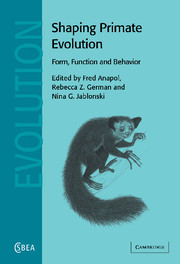Book contents
- Frontmatter
- Contents
- List of contributors
- Preface: shaping primate evolution
- 1 Charles Oxnard: an appreciation
- Part I Craniofacial form and variation
- Part II Organ structure, function, and behavior
- 6 Fiber architecture, muscle function, and behavior: gluteal and hamstring muscles of semiterrestrial and arboreal guenons
- 7 Comparative fiber-type composition and size in the antigravity muscles of primate limbs
- 8 On the nature of morphology: selected canonical variates analyses of the hominoid hindtarsus and their interpretation
- 9 Plant mechanics and primate dental adaptations: an overview
- 10 Convergent evolution in brain “shape” and locomotion in primates
- Part III In vivo organismal verification of functional models
- Part IV Theoretical models in evolutionary morphology
- Part V Primate diversity and evolution
- Index
- References
7 - Comparative fiber-type composition and size in the antigravity muscles of primate limbs
Published online by Cambridge University Press: 10 August 2009
- Frontmatter
- Contents
- List of contributors
- Preface: shaping primate evolution
- 1 Charles Oxnard: an appreciation
- Part I Craniofacial form and variation
- Part II Organ structure, function, and behavior
- 6 Fiber architecture, muscle function, and behavior: gluteal and hamstring muscles of semiterrestrial and arboreal guenons
- 7 Comparative fiber-type composition and size in the antigravity muscles of primate limbs
- 8 On the nature of morphology: selected canonical variates analyses of the hominoid hindtarsus and their interpretation
- 9 Plant mechanics and primate dental adaptations: an overview
- 10 Convergent evolution in brain “shape” and locomotion in primates
- Part III In vivo organismal verification of functional models
- Part IV Theoretical models in evolutionary morphology
- Part V Primate diversity and evolution
- Index
- References
Summary
Gravity: the most compelling factor in the evolution of primate locomotor systems
Inflationary increase in the number of space flights and length of time spent in space stations – likely to become casual trips for wealthy tourists – has brought to light how much the structure and function of the locomotor system depend upon gravitational force. The sort of “swimming” movements of astronauts within space stations have become familiar images on our TV screens. Adaptation to weightlessness for an easy life in space has required scientists to analyze and overcome the alterations generated in muscles by the absence of weight constraints. Astronauts are well aware of the changes occurring within their body in the microgravitational environment, as well as their reversal during the recovery phase following return to earth. Astronauts' sensations are in accordance with experimental results drawn from flown rats and macaques. Changes in muscle structure were reported first in rats, after only two weeks in space (Desplanches et al., 1987; Riley et al., 1990; Desplanches, 1997; Fitts et al., 2001). Significant advances in our understanding of the effect of gravity on the primate muscle system resulted from two series of studies of flown rhesus monkeys (Macaca mulatta) during 14- and 12-day space flights: (1) COSMOS 2044, COSMOS 2229 (Bodine-Fowler et al., 1995; Roy et al., 1996) and (2) BION 11 (Roy et al., 1999, 2000; Belozerova et al., 2000; Mounier et al., 2000; Chopard et al., 2000; Fitts et al., 2000a, 2000b, 2001; Kischel et al., 2001).
- Type
- Chapter
- Information
- Shaping Primate EvolutionForm, Function, and Behavior, pp. 134 - 161Publisher: Cambridge University PressPrint publication year: 2004
References
- 4
- Cited by



